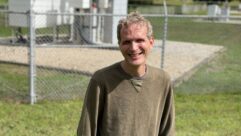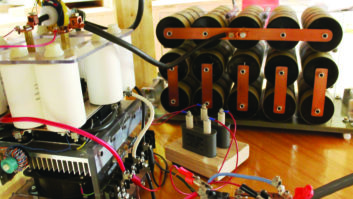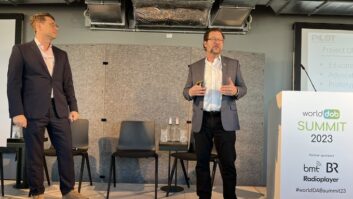For nearly a quarter of a century, a small group of Nikola Tesla faithful have gathered in Brockport, N.Y., just a few miles from where the Serbian electrical genius helped to engineer the world’s first hydroelectric generating plant and forever established the superiority of alternating current for electrical distribution. They meet to pay homage to the inventor.

The occasion is a “Teslathon” sponsored in the late summer by Tesla enthusiast Ed Wingate. Admission is limited to a few dozen persons and some travel thousands of miles to pay homage to Tesla and witness the unleashing of manmade thunderbolts in Wingate’s lab.
TESLA AND RADIO
While Tesla’s name is associated with generating electricity of extremely high voltage, some argue that he should be called the father of radio, too, as he may have beaten Guglielmo Marconi to the punch.
Tesla publicly exhibited a wirelessly-controlled model submarine at a New York exposition in 1896, and at about the same time, was set to demo wireless signaling between his New York City lab and West Point, N.Y., when a fire sidetracked things.
It would appear that Tesla and Marconi were both interested in using “Hertzian waves” for communication, but Tesla changed directions, focusing instead on high-frequency, high-voltage electricity apparatus, polyphase AC power evangelism and wireless transmission of electrical power.
Marconi’s focus remained on communications, and he’s generally credited as the individual who put radio to work. However, Marconi relied on Tesla’s resonant transformer technology to power the apparatus that sent the fabled three “dits” across the Atlantic in late 1901, and after lengthy litigation over priority in U.S. radio patents, the Supreme Court upheld Tesla’s priority over Marconi.
HIGH-FREQUENCY, HIGH-VOLTAGE HERITAGE
Today, more than 70 years after Tesla’s passing, experimenters still delight in building tuned resonant transformer voltage “step-up” devices — Tesla coils — to create high-frequency discharges.
Ed Wingate is one of those persons.
“I’ve always enjoyed seeing electrons jump through the air from one place to another, and I’ve been interested in high voltage and technical things since I was in the eighth grade,” said Wingate. “That’s when I built my first Tesla coil. I entered it in the eighth grade science fair and won first place.”
Wingate, now 67, has been building bigger and better Tesla coils ever since, with the latest iteration powerful enough to send thick arcs across tens of feet.
Wingate never pursued a career in electricity or electronics, nor has he had any formal training in the subject. He retired several years ago after 31 years as a tool and die maker at Eastman Kodak, learning electricity strictly from self-study and as he puts it, “the school of hard knocks.”
In 1991, his home workshop could no longer contain the large sparks he was generating, and he constructed a 30×40×14-foot laboratory to accommodate his experimentation. Even this structure is no longer adequate, as the heavy discharges easily reach the ceiling, walls and floor of the structure.
”When you do stuff like this, you really have a need to show someone else what you’re doing,” said Wingate. “I could come home and fire up my coils and watch them all night, but it’s not as fun as sharing them with someone.”
Wingate began opening up his lab to invited guests in 1992, his first Teslathon. He’s careful to note that was not the first Teslathon, as other super high-voltage electricity devotees were hosting similar events earlier. However, those gatherings have either been discontinued or are now focused on other areas.
In addition to demonstrating large-scale electrical discharges, Wingate uses his Teslathon to bring established “coilers” together and to encourage others to create their own apparatus and show it off.
“We do this to disseminate knowledge. We are trying to get people up to speed on how to find materials, how to build the coils, what not to do, what to do so people don’t have to struggle to get the information.”

THE TESLA COIL EXPLAINED
So how does one go about stepping up “sane” electrical potentials to the thousands or millions of volts and the big discharges that Tesla followers “ooh” and “ahh” over?
The Tesla secret lies in the use of an air-core transformer driven by a high-frequency AC source with the transformer primary and secondary tuned to resonate at a particular frequency.
In examining the basic Tesla coil circuit, it’s difficult not to notice the similarity to a spark radio transmitter from a hundred years ago. In both, an iron-core transformer steps up line voltage to the kilovolt range and a high-voltage capacitor or “condenser” is connected across the transformer’s secondary. One leg of this transformer/capacitor pair connects directly to the primary of an air-core transformer (antenna coupling transformer). The path from the other side of the secondary to the air core transformer is broken by a spark gap. This gap is adjusted so that when the capacitor reaches a sufficient state of charge, the gap breaks down (ionizes) and momentarily connects the capacitor in parallel with the air-core transformer primary. This forms a tuned circuit with the capacitor and inductor exchanging energy in an oscillatory fashion. Operating frequency is roughly determined by the inductance of the air-core winding and the capacitor value. High frequency alternating current energy (RF) from the secondary of the air-core transformer is fed to an antenna. (The transformer secondary is tuned after a fashion by capacitance between the antenna and ground.)
The Tesla coil schematic is virtually identical, with the exception of a metal toroid or “capacity hat” replacing the antenna and providing the capacitance for resonating the coil’s secondary.
Spark transmitter and spark-excited Tesla coil similarities are driven home in an August 1911 “Electrician and Mechanic” article written by Stanley Curtis on constructing a Tesla-type high-voltage machine:
“The primary helix of the resonator and the transformer with condenser constitute the chief essentials for a high-grade wireless telegraph installation and by winding a second drum with 30 turns of narrow copper ribbon, this to replace the secondary of the resonator, the builder will have an oscillation transformer which will give good service in a wireless installation.

DANGEROUS ELECTRICITY
To excite his big coil, Wingate uses a 14.4 kV power company distribution transformer or “pole pig” connected in reverse to step up 240 V mains power. The transformer is sized to accommodate the 13 kW drawn from the mains. A wrong move with electricity at this level can be lethal, so it’s no place for inexperienced or careless experimenters.
“There’s always the danger of electrocution,” said Wingate. “But generally by the time that people get to building the size coil I built, they are knowledgeable enough so they don’t do anything bad to themselves.”
In addition to “keeping one hand in the pocket” and checking and double-checking everything before powering up, Wingate advises those who might want to follow his path to not work alone.
“Start small, work your way up, get yourself together with people who know what they are doing. It’s supposed to be a fun hobby, not a deadly hobby.”
Wingate notes that, while many experimenters have constructed Tesla coils, perhaps only two dozen U.S. Tesla enthusiasts have built really large coils with outputs in the megavolt range. He adds that there’s sometimes a tendency to overestimate output potentials.
“Voltage claims sometimes get exaggerated,” said Wingate. “The way a Tesla coil works is that an ‘arc channel’ is initially created, with subsequent sparks moving through the channel and becoming lengthened in the process. Each successive spark takes less voltage to push through the arc channel.”
THE COIL IN OPERATION
Demonstrations of Wingate’s giant coil are performed in a semi-darkened room to more dramatically show off the thunderbolts created.
In starting the demos (referred to by coilers as “runs”), Wingate activates a rotary spark gap and then uses a large Variac to slowly raise voltage being fed to the pole pig. As voltage is ramped up, oscillatory action starts and the light (and sound) show begins.
When moving across an open space, electricity at this potential is a sight to behold. The discharges appear to take on a life of their own, rising and falling slowly, undulating unpredictably in almost a snake-like manner, all the time seeking something to strike. Noise from the giant arc and the rotary spark gap is so great that hearing protection is mandatory.

CIRCUIT ELEMENTS
The majority of such big coils are fashioned from components made by coilers themselves, with usually the only “off-the-shelf” items being the AC transformer and perhaps the high-voltage capacitor.
“Herb Feldhouse, an engineer at Condenser Products, designed a special pulse discharge capacitor for Tesla coil use,” said Wingate. “The caps are rated at 0.1 mfd at 40 kV and cost somewhere in the neighborhood of $400 each.”
He uses two such capacitors in series in his coil, operating them in the Tesla “equidrive” configuration.
Wingate’s rotary spark gap is equally special.
“This is my own design. There are 12 separate gaps and all are breaking at the same time. The quench time is extremely fast — down in the 10 microsecond range.”
Coilers rely on a variety of materials for coil forms. Smaller coils can be constructed from PVC pipe, while cardboard tubes used for forming concrete have been used for larger coils. Wingate’s coil is constructed around a polyethylene agricultural spray tank 37 inches in diameter and 48 inches high.
MOVING BEYOND SPARK
As radio evolved, spark oscillators gradually fell out of favor due to inefficiency and the “spread spectrum” nature of their signals.
Coilers also moved on into new technologies too. Vacuum tube-excited coils began to appear in the 1930s and schematics for tube-type coils frequently appeared in hobbyist magazines.
Now that silicon devices have become more robust, some Tesla buffs use solid-state components to power their coils. Advantages include lower primary voltages, compact size and the ability to easily vary operating frequency. (Coilers have taken advantage of this latter attribute to construct coils with discharges modulated by music.) Wingate has worked with tube designs and now is getting ready to try his hand at solid state.
“I’m building a dual-resonant solid-state Tesla coil,” he said. “The coil will use CM600 insulated gate bipolar transistors which are good for 600 amps at 1,200 volts.”
BEING A GOOD NEIGHBOR
Even though his megavolt coil is at heart a large radio transmitter, Wingate has no interest in trying for a 21st century spark communication record.
He also noted that most coilers recognize the communications-disruptive nature of their creations and try to avoid interfering with nearby electronic devices.
“My entire lab is a Faraday cage,” said Wingate. “Every panel in the [metal] building and roof is tied together with jumpers and grounded with common ground rods. In the power panel I have a bank of EMI filters to keep RF from going into the line to keep the neighbors happy.”
Speaking of neighbors, Wingate says “Don’t lie to them; let your neighbors know what they are doing. Most people are pretty receptive, but if you try to be secretive they can manufacture all kinds of things that may not be true. Honesty is best!”
Find numerous past history articles by James O’Neal by scrolling through the Roots of Radio tab under the Columns heading at radioworld.com.












